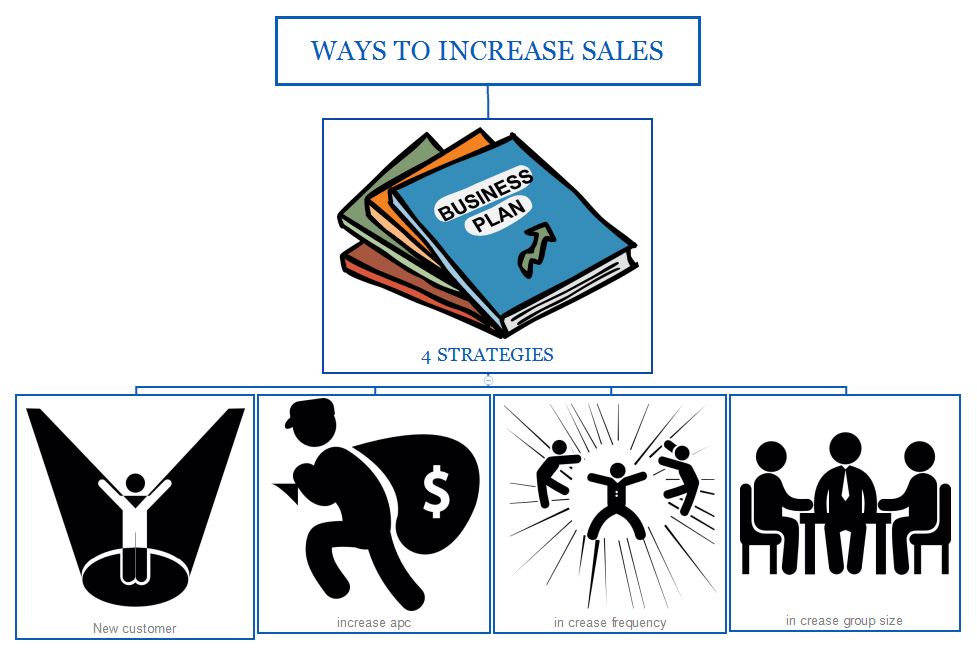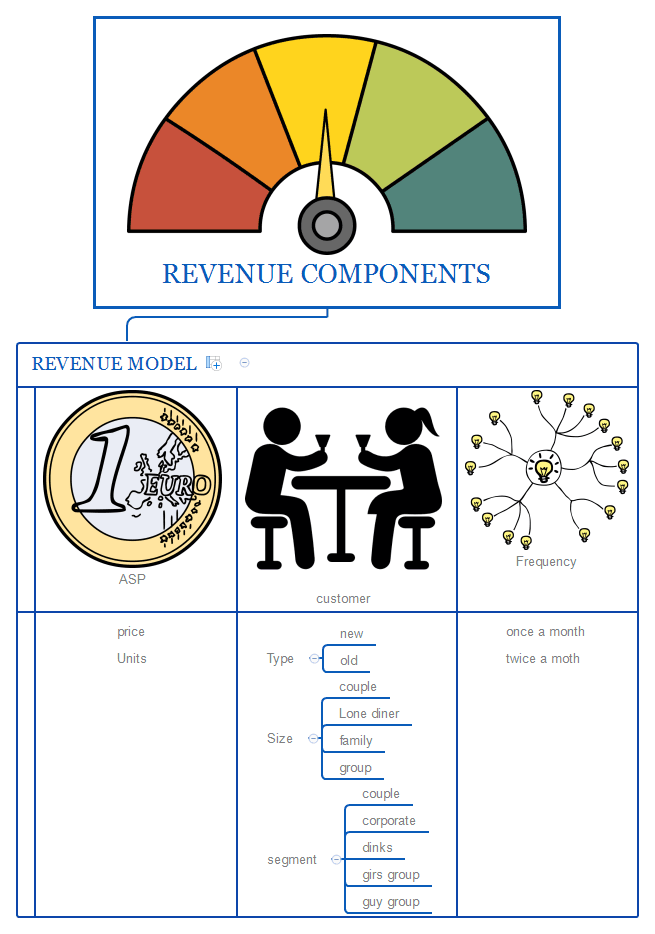Ways to Increase Restaurant Sales.
You are running a restaurant and one of the challenges you will always face is how to increase restaurant sales? Before you pursue any promotion, you need to recognise that there are only four ways to increase restaurant sales. All initiative must be seen as how they move the restaurant one of the four ways to increase restaurant sales.
As a restaurant operator, there is relentless pressure on increasing sales. There is a pressure to meet the targeted bottom-line or there is pressure to meet payroll or increase in sales just needed to meet the increase in rent.
Understand these 4 ways and you will be on a path to profit.
There are fundamentally only four ways to increase sales.Get new customers, increase the average spend, increase the frequency of visit or increase the group size.
Even though the industry has evolved there are still just 4 ways to increase sales. There may be a different tactic in each of the ways. But they all rest under these ways.
Use the 4 Ways To Increase Sales By Understanding Restaurant Revenue Model
To understand how to use these four ways to increase restaurant sales, you need to look at the components of revenue.
The revenue a restaurant earns is function of number of people who visit, how often they come and the price they pay. Each of these can be further subdivided.
Why is all this important?
Your strategy to increase sales will work on one or more of parts of revenue model.
A revenue model of a restaurant has primary three components.
- Average selling price,
- customers and
- the frequency of visit.
Average Selling Price
The average selling price is a combination of the price of goods and the units sold.
Number of Customers
The number of customers who buy can be further divided into types, size and segments. The first question is the customer old or new customers. We can look at the party size-couple, lone diner, family or group. We can examine which customer segment here she belongs-couple, corporate, family, girl groups, Guy groups.
Frequency of Visit
The third element is frequency. The frequency of the visit once a month, once in 15 days or every week.
You can achieve your goal to increase restaurant sales by having a data-driven understanding of your revenue model.
By examining these components with respect to the four ways to increase sales can result in lots of programs to implement.
Get New Customers.
Whether you are an old restaurant or a start-up, you will always need new customers to visit you. As an established brand, you need to recognise that there will be a constant churn in your customer base. Some of them believe your trading area and move somewhere else. Some will just outgrow the restaurant and some will want to try out new places.
The restaurant needs to have a set of restaurant marketing strategies to attract new customers. Now, this may not seem obvious to a restaurant operator, however, most of the restaurant budgets on restaurant marketing are spent on new customer acquisition to increase restaurant sales. And my advice is that it’s important to spend money on your customer acquisition but certainly not all your money.
Increase Average Spend.
You can increase your revenue by focusing on your existing customer base and asking them to spend more on the meal. This strategy requires many engineering, training of staff, new product development and simply increasing prices.
An intelligent way to do this is to plan your menu for profit. It is by understanding your mix and its implication on the bottom line. In a sense, your menu needs to be linked via profit and loss statement. It is a prerequisite that you have a clear idea on what sells and how much is each menu item costs and that you diligently prepare a profit loss statement.
Increase Frequency.
Make them come again. This is how this strategy can be explained.
All things being equal, a mere 10% increase in the frequency of visit will almost double your profit. A large percentage of incremental increase in restaurant sales goes directly to the bottom line.
This is so powerful one wonders why don’t many people try this. You enjoy your customer’s trust. You are a known for creating a memorable experience, a little push and they will come back for more. They just need a reason to come back again.
Each restaurant irrespective of the segment operates in can adopt the strategy. The sooner a strategy but more like a goal. And I will qualify that this goal must be backed by suitable strategy. Your restaurant needs to have a goal, backed by an action plan. Your action plan is supported by resources, procedures or process improvement and task plan. An SMS campaign or using shortcode is an effective resource to help you in the realisation of the goal.
Increase Group Size.
You need a dedicated strategy to get groups to dining in a restaurant. The paradigm is very simple is that when people coming groups the total bill size will be much more than when they come in a table of two or four.
Is been my observation that if you get an optimum group size than the average spend is per person for exceeding smaller parties of two, three or four. Promotions like Fathers Day which may get three generation on your table is one way to use events. A thoughtful buffet is an excellent program to increase group size and average spends.
Most Expensive Way
As stated earlier, most restaurant operators tend to focus on new customer acquisition. And tend to have a benign neglect to the other three opportunities. It is most expensive to acquire a new customer. The customer needs to be sold to the idea that your restaurant is worth the time and effort. It takes a lot of communication, messaging and advertising to make him try your restaurant. In a sense, this is an expensive proposition.
By far the easiest and the most desirable is to increase the frequency of visit. The customer already likes you. All you need to do is give him a reason to visit again.
Increasing average spend can and needs to be done. By using new product development, menu engineering, staff training it is possible to shift the customer at a higher average spend. Customers who enjoy hospitality will also not mind an increase in prices.
Increasing group size requires a targeted effort for group dining. This has to be in the arsenal of every restaurant. Even if you are a delivery kitchen you need to have a program in place to achieve this. Increase in group size can have a dramatic impact in increasing restaurant sales.
As stated these four can be stated as strategy or goals. These need to have an action plan which will help to achieve one or more of these goals. The action plan can be unique to every restaurant. But the end goal may be the same. A restaurant needs to keep a tab on competition and examine their promotion efforts. Learn from them and recognise their mistakes.
Prerequisites to increase restaurant sales
The success and the achievement of these goals are dependent on that the fundamentals are in place. You have a meal experience which customers like, you have strong operations and systems in place to deliver consistent meal experience.
Simply stated you have a great product. There are a product and a market for it. And you have kick ass operations.
The realisation of these goals may require tactical programs on a week to week basis or medium-term process improvement and product development.
These goals or strategies are not a substitute for long-term improvement or realisation of a positioning. A food and beverage operation positioning may hinge on-
- product & service quality,
- hospitality and customer intimacy,
- customization,
- responsiveness or
- the total cost of ownership.
The realization and strengthening of their chosen dimension will require work on several aspects of their operations.
The pursuit of the 4 ways must be in the context of their desired positioning.
Conclusion
In conclusion, 4 ways to build sales are by focusing on getting new customers, increasing average spend, increasing group size and increasing their frequency of visit. New customer acquisition is hardest and most expensive. Increasing frequency of visit is the easiest and most profitable. Each food and beverage operation can create programs which are unique to them and target more than one of the above goals. What a restaurant does is dependent on which dimension of service it has positioned itself to offer.




